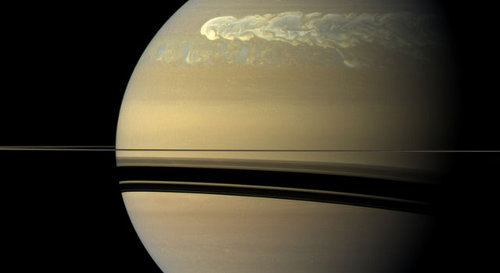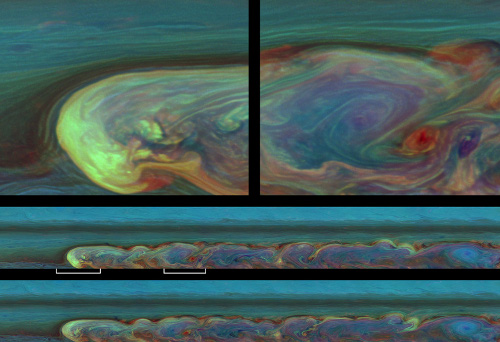Centauri Dreams
Imagining and Planning Interstellar Exploration
A Neptunian Year Considered
When the German astronomer Johann Gottfried Galle discovered Neptune on September 23, 1846, he found a world so distant from the Sun that its orbit takes 165 years to complete. With Neptune reaching its first complete revolution since discovery, an event that occurred yesterday, we can enjoy some celebratory Hubble imagery of the planet. I especially like the shot below, which not only shows atmospheric features but also has been tweaked to reveal some of Neptune’s moons. The planet has about thirty moons, most of them too faint to appear in these images.
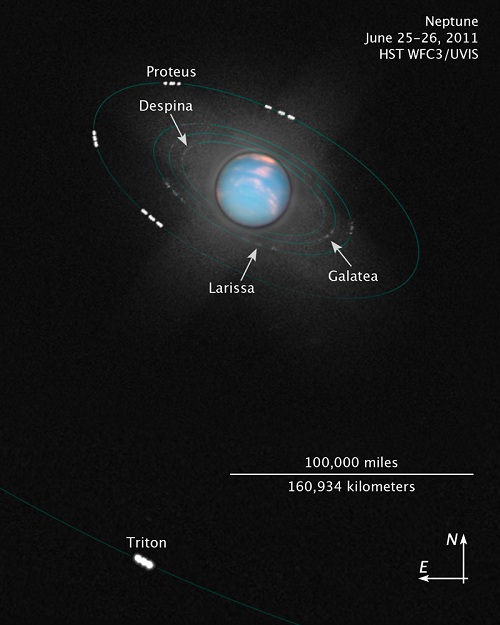
Image: This illustration was composed from numerous separate Hubble Wide Field Camera 3 images. A color image composed of exposures made through three color filters shows the disk of Neptune, revealing clouds in its atmosphere. Forty-eight individual images from a single filter were brightened to reveal the very faint moons and composited with the color image. The white dots are Neptune’s inner moons moving along their orbits during Hubble’s observations. The solid green lines trace the full orbit of each moon. The spacing of the moon images follows the timing of each Hubble exposure. Triton, in the lower left corner, is the brightest of the moons seen in these images, farthest from the planet, and moves in a counter-clockwise sense in this view. Next closest to Neptune is Proteus, followed by Larissa, Galatea and Despina, all of which move clockwise in this view, opposite to Triton’s (retrograde) motion. Credit: NASA, ESA, and the Hubble Heritage Team (STScI/AURA).
The four images below were taken with Hubble’s Wide Field Camera 3 in late June, spaced at four hour intervals to offer a full view of the planet’s 16-hour rotation. You can make out high-altitude clouds of methane ice crystals in the northern and southern hemispheres. And just as we’ve recently looked at seasonal changes on Saturn, the Hubble imagery reveals similar changes on Neptune, with cloud activity shifting to the northern hemisphere. The southern hemisphere is now in early summer, while the northern hemisphere has entered winter. Neptune has an axial tilt of 29 degrees, creating seasons that last for some forty years each.
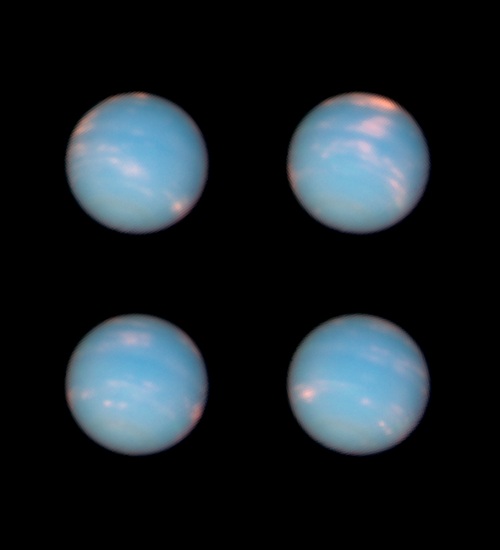
Image: In the Hubble images, absorption of red light by methane in Neptune’s atmosphere gives the planet its distinctive aqua color. The clouds are tinted pink because they are reflecting near-infrared light. A faint, dark band near the bottom of the southern hemisphere is probably caused by a decrease in the hazes in the atmosphere that scatter blue light. The band was imaged by NASA’s Voyager 2 spacecraft in 1989, and may be tied to circumpolar circulation created by high-velocity winds in that region. The temperature difference between Neptune’s strong internal heat source and its frigid cloud tops, about minus 260 degrees Fahrenheit, might trigger instabilities in the atmosphere that drive large-scale weather changes. Credit: NASA, ESA, and the Hubble Heritage Team (STScI/AURA).
The story of Neptune’s discovery is a fascinating topic in itself. Galileo actually recorded Neptune in his notebooks but didn’t follow up the observation. British astronomer William Herschel would later note that the orbit of Uranus did not behave as expected according to Newton’s laws, leading to speculations (like those of French astronomer Alexis Bouvard in 1821) that another planet was tugging at Uranus. Both Urbain Le Verrier and John Couch Adams predicted the location of the putative planet in the 1840s, but it was Le Verrier who described his prediction to Galle at the Berlin Observatory. After that, it was a matter of two nights of observation before Galle was able to identify the planet. Although the Royal Society would award Le Verrier the Copley Medal for his work, supporters of Adams defended his right to be considered a co-discoverer. Recent work has cast doubt on the idea.
Neptune makes numerous appearances in science fiction, such as Samuel Delany’s Triton (1976) and Jeffrey Carver’s Neptune Crossing (1994), in both of which much of the action takes place on Neptune’s largest moon. But earlier appearances are interesting, including Olaf Stapledon’s Last and First Men (1930), in which the planet serves as humanity’s final home. H.G. Wells likewise wrote about Neptune in ‘The Star’ (1897), a short story in which the planet is destroyed by a collision with what appears to be a rogue wandering planet from the interstellar deep. The event puts a brilliant new star in Earth’s sky, one that inexorably approaches our planet. Interestingly, the massive new object now gets a gravitational assist from Jupiter, as foreseen by a canny mathematician who forecasts the end of the human race:
The new planet and Neptune, locked in a fiery embrace, were whirling headlong, ever faster and faster towards the sun. Already every second this blazing mass flew a hundred miles, and every second its terrific velocity increased. As it flew now, indeed, it must pass a hundred million of miles wide of the earth and scarcely affect it. But near its destined path, as yet only slightly perturbed, spun the mighty planet Jupiter and his moons sweeping splendid round the sun. Every moment now the attraction between the fiery star and the greatest of the planets grew stronger. And the result of that attraction? Inevitably Jupiter would be deflected from its orbit into an elliptical path, and the burning star, swung by his attraction wide of its sunward rush, would “describe a curved path” and perhaps collide with, and certainly pass very close to, our earth. “Earthquakes, volcanic outbreaks, cyclones, sea waves, floods, and a steady rise in temperature to I know not what limit”–so prophesied the master mathematician.
‘The Star’ is still a good read (Wells’ Martians even make an appearance). You can read it online here, an enjoyable way to celebrate Neptune’s first full year since discovery.

Supernovae: Factories of Cosmic Dust
The supernova called SN 1987A is a prime object for scrutiny because it gives us the chance to see the various phases of stellar death over time. And as you might guess from the fact that it was visible to the naked eye when first detected back in 1987, it’s located relatively nearby, in the Large Magellanic Cloud. Working in the far-infrared, the European Space Agency’s Herschel space observatory has made new discoveries about SN 1987A while studying this small galaxy’s cold dust emissions.
The surprise result: SN 1987A is shrouded with enormous amounts of dust, 10,000 times more than previous estimates. The dust was at a temperature of roughly minus 256 to minus 249 degrees Celsius, making it a bit colder than Pluto (minus 240 degrees Celsius). These are the first far-infrared observations of this object, showing that the dust is emitting more than 200 times the energy of the Sun. Moreover, there is enough dust here to account for 200,000 planets the size of the Earth. Thus we learn that supernova explosions can be true dust factories.
Looking at SN 1987A with different instrumentation has proven valuable. The image below contrasts what Herschel can see versus the view from the Hubble Space Telescope. Here we’re contrasting Hubble with Herschel’s ability to see much longer wavelengths, and gaining a broad, composite picture of supernova dust formation.
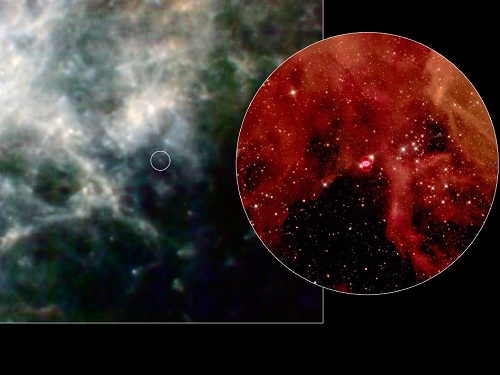
Image: This layout compares two pictures of supernova remnant SN 1987A — the left image was taken by the Herschel Space Observatory, and the right is an enlarged view of the circled region at left, taken with NASA’s Hubble Space Telescope. The tiny pink ring in the Hubble image shows where a shock wave from the blast is hitting the surrounding material expelled from the star before the explosion. The cause for the outer, faint rings is unknown. When Herschel observed SN 1987A, it saw something different. Herschel sees infrared and submillimeter light, much longer in wavelength than the visible light Hubble detects. For this reason, its picture of the supernova is not as sharp, appearing only as a fuzzy dot inside the circle. But that dot represents an important discovery of vast reservoirs of cold dust around SN 1987A. Herschel can see very cold material — the colder something is, the longer the wavelengths of light it emits. Credit: ESA/NASA-JPL/UCL/STScI.
We need to learn as much as we can about cosmic dust because the heavy atoms — carbon, silicon, oxygen, iron — that it contains were not produced in the Big Bang but later. These elements are major constituents of the rocky planets and key players in life itself. And while old red giant stars in today’s universe are thought to be major dust producers as their gases flow outward from the star, they would not have been present for this purpose in the very early universe. But dust condensing from the gaseous debris of a supernova would have become available early on, accounting for the dust seen in young galaxies observed at huge distances from Earth.
“The Earth on which we stand is made almost entirely of material created inside a star,” explained the principal investigator of the survey project, Margaret Meixner of the Space Telescope Science Institute, Baltimore, Md. “Now we have a direct measurement of how supernovae enrich space with the elements that condense into the dust that is needed for stars, planets and life.”
We also see the value of probing the universe with different wavelengths, such as Herschel’s far-infrared. While we’ve had previous studies on supernovae and their ability to produce dust (NASA’s Spitzer Space Telescope, working with shorter infrared wavelengths than Herschel, found 10,000 Earth masses of fresh dust around the supernova remnant called Cassiopea A), this detection of a much larger reservoir of dust around SN 1987A confirms and extends our knowledge. The closest supernova witnessed in almost 400 years has proven a useful object indeed.
The paper is Matsuura et al., “Herschel detects a massive dust reservoir in supernova 1987A,” published in Science Express on 7 July 2011 (abstract). More in this JPL news release.

Report from the UK Space Conference
By Rob Swinney
Rob Swinney is a freelance writer, a member of the British Interplanetary Society and an active participant in the Tau Zero Foundation/BIS study group Project Icarus, a team of volunteers working on a practical design for an interstellar probe. Rob completed his Bachelors degree in Astronomy and Astrophysics at the University of Newcastle Upon Tyne and his Masters in Radio Astronomy at the University of Manchester (Jodrell Bank). Later he graduated from Cranfield University (then the Cranfield Institute of Technology) with a Masters degree in Avionics and Flight Control Systems. After a rewarding career in the Royal Air Force as an Aerosystems Engineer (Avionics) Officer he completed his Commision in 2006 having attained the rank of Squadron Leader. He is a Chartered Engineer registered with the UK’s Engineering Council and a Member of the Institution of Engineering and Technology. Rob recently attended the UK Space Conference on July 4 and 5th and here offers us a personal view of the proceedings. Space agencies worldwide are challenged by budget cuts and the need to develop a new vision as we enter the age of commercial space. Our recent discussions here highlighted the problems of the US space program in particular. How do things look in the UK and the European Space Agency?

The UK Space Agency emerged from the forerunner British National Space Centre. This week the agency hosted the UK’s Space Conference 2011 at Warwick University, England, where economic issues came to the fore. The agency has an apparently vastly increased budget of several hundred millions of pounds although this was created by merging funds from other areas and the figure is still well below the amounts spent by the other major European economies.
The conference, whose theme was ‘The New Space Economy,’ brought together members of the space community from industry, government and academia and painted a positive picture of the space sector in the UK, which is estimated to be worth £7.5 billion per year (over $10 billion), a figure the new agency hopes to help grow to over £40 billion in the next 20 years. There was definitely a ground swell of positive opinion about the skills in the UK to build small satellites and other specific areas of the sector that can offer business opportunities.
Interestingly, David Willetts, a Member of Parliament and the UK Minister of State for Universities and Science, suggested the health of the UK space sector was in such a good state because there hadn’t been a government agency involved in the past and this had been to its advantage. It is perhaps unclear how ringing an endorsement this is of the move to governmental executive agency status. But Willetts did announce a number of policies to try and improve the environment for doing ‘space’ business in the UK, one of which was to lower the mandatory third party insurance limit from £100m to £60m (for launch and orbital operations).
Even if the agency just focuses on lowering costs and red tape there is little chance of the UK market not growing to £40 billion in the timeframe allowed given the rate of growth for the last 10 years – even through the recession we are now experiencing. Perhaps more challenging is the aim to grow the market share of worldwide space products and services from 6 to 10%.
What the Agency actually does with its £230 million budget is then open to debate. The good news for the European Space Agency (ESA) is that it looks like more of that money will end up being pushed through to ESA. The bad news is that it is really not a lot of money anyway and only a fraction of the totals of other European countries such as France and Germany. Even so, the importance of the UK involvement with ESA was apparent from the first session, ‘Space Policy,’ which included the ESA Director General Jean-Jacques Dordain, who helped set the scene. Dordain stated that although the conference had started on America’s Independence Day, “Together we are better.” Independent agencies cooperating skillfully can achieve much.
Various tracks were offered in the parallel sessions and on the first day I attended the ‘Science and Exploration’ session followed the next day by ‘Student presentations’ and then ‘Access to Space.’ There was an interesting mix. Much in evidence was the prototype British eccentric, perhaps a throw-back from an earlier age of brilliant endeavour but also a marker for the new generation of young enthusiasts fronted by UKSEDS, the UK chapter of the Students for the Exploration and Development of Space. Also in evidence were the hard headed business people who play so significant a role in the success and focus of the space business in the UK.
The second day opened with a panel session on ‘Innovation – Science, Business and Technology’ and included UK industry ‘giant’ Sir Martin Sweeting OBE, the executive chairman of Surrey Satellite Technology Ltd., along with innovator Alan Bond, Managing Director of Reaction Engines Ltd. and a key player in the original Project Daedalus starship design.
Bond discussed the challenges facing an innovator, especially when working with game-changing technology. This is clearly not a UK-specific issue, but he did lament the lack of support from government, industry and the banks, while noting the many skills and commitments innovators had to excel at in addition to their expertise in their field (e.g. becoming brilliant at presenting and communicating the idea, attending conferences at their own expense, working with economists and creating business plans, negotiating patent law as well as being a technical expert).
Bond said that innovators were usually young and naïve and would find that they had to live with less and less of the financial rewards of their innovation. I’m not sure if he was thinking of himself and the Reaction Engines Skylon spaceplane and its SABRE engine but he did mention that the technology first appeared some 40 years ago and that it has been fully 29 years since the start of the development. Perhaps the most valuable lesson he gave was perseverance!
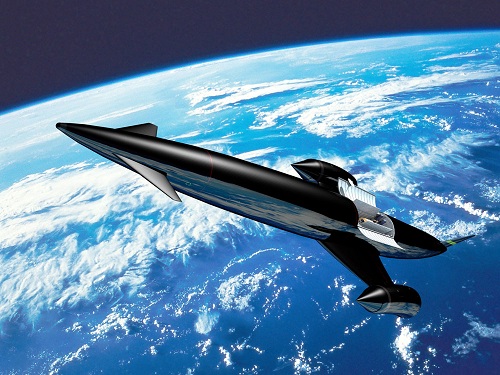
Image: Skylon is the design for an unmanned, reusable spaceplane intended to provide low-cost access to space. The SABRE engines that would drive it offer both air-breathing and conventional rocket capabilities, the intent being to reach orbit in a single stage. Skylon is currently in its proof-of-concept phase. Is this the low-cost way to LEO we once imagined the Space Shuttle would be? Credit: Reaction Engines Ltd.
It is perhaps unclear how the UK Space Agency might have changed this process as its focus is on partnering with others and possibly some small independent projects.
It doesn’t look like there are any immediate plans to support blue sky thinking as far out as interstellar flight. Project Icarus may have to continue on its voluntary way. Indeed I heard interstellar distances mentioned only once and then only as a way of illustrating relative distances — e.g. if you imagine the Earth about the size of a large grapefruit, then the distance from Earth to our Moon is about 4m (a scale of 1,000,000:1), making the distance to the nearest stars the distance of the actual Moon, some 250,000 miles away. An interstellar conference this was not, but full marks to the organisers for putting together a successful look at current policy.

Saturn: A Turbulent Early Spring
I had been intending to cover recent news about Saturn in an upcoming post anyway, but the images below sealed the deal. They’re further wonders from Cassini, pictures of a massive storm in Saturn’s northern hemisphere that encircles the planet. First detected on December 5, 2010, the storm has been on the rampage ever since at about 35 degrees north latitude. It covers approximately 4 billion square kilometers. Cassini’s radio and plasma wave science instrument has been showing a lightning flash rate 10 times that of any other storms the spacecraft has monitored since its arrival in Saturn orbit back in 2004. The flashes were so frequent at one point that Cassini could no longer resolve individual strokes, although the intensity has now eased.
Image: The huge storm churning through the atmosphere in Saturn’s northern hemisphere, seen here in a true-color view from NASA’s Cassini spacecraft. This view looks toward the sunlit side of the rings from just above the ring plane. The image, captured on Feb. 25, 2011, was taken about 12 weeks after the storm began, and the clouds by this time had formed a tail that wrapped around the planet. Some of the clouds moved south and got caught up in a current that flows to the east (to the right) relative to the storm head. This tail, which appears as slightly blue clouds south and west (left) of the storm head, can be seen encountering the storm head in this view. Credit: NASA/JPL-Caltech/SSI.
It’s interesting to realize that the shadow cast by Saturn’s rings has strong effects on the planet’s weather. This storm is 500 times the area of the largest southern hemisphere storms Cassini has seen on its mission, and scientists are suggesting that we are now seeing such powerful storms in the northern hemisphere because of the change of seasons after the planet’s 2009 equinox. At present, Saturn is entering early northern spring, making this a relatively early storm. In previous years, Earth-based astronomers as well as Hubble have observed huge storms called ‘Great White Spots’ in late northern summer, some of which were as large as this one. Unfortunately, we didn’t have Cassini or Voyager on the scene for previous storms of this magnitude.
“This storm is thrilling because it shows how shifting seasons and solar illumination can dramatically stir up the weather on Saturn,” said Georg Fischer, a radio and plasma wave science team member at the Austrian Academy of Sciences in Graz. “We have been observing storms on Saturn for almost seven years, so tracking a storm so different from the others has put us at the edge of our seats.”
We’re looking at a storm that covers an area eight times the surface area of Earth. Since its arrival, Cassini has detected 10 lightning storms on Saturn, found in an area of the southern hemisphere now known as ‘Storm Alley.’ We’re now getting a glimpse of just how lively a Saturnian spring can be as the Sun’s illumination of the hemispheres changes. The storm is generating huge amounts of radio noise from lightning. At issue is the sudden release of such energies, unlike what we see on Jupiter or, for that matter, the Earth, where numerous storms are active at any given moment. In sharp contrast, Saturn seems quiet for years and then erupts into frenzied activity.
Image: False-color images from Cassini showing clouds at different altitudes. Clouds that appear blue here are the highest and are semitransparent, or optically thin. Those that are yellow and white are optically thick clouds at high altitudes. Those shown green are intermediate clouds. Red and brown colors are clouds at low altitude unobscured by high clouds, and the deep blue color is a thin haze with no clouds below. The base of the clouds, where lightning is generated, is probably in the water cloud layer of Saturn’s atmosphere. The storm clouds are likely made out of water ice covered by crystallized ammonia. Taken about 11 hours — or one Saturn day — apart, the two mosaics in the lower half of this image product consist of 84 images each. The mosaic in the middle was taken earlier than the mosaic at the bottom. Both mosaics were captured on Feb. 26, 2011, and each of the two batches of images was taken over about 4.5 hours. Credit: NASA/JPL-Caltech/Space Science Institute.
The storm on Saturn made the cover of Nature this week. The papers involved are Sánchez-Lavega et al., “Deep winds beneath Saturn’s upper clouds from a seasonal long-lived planetary-scale storm,” Nature 475 (7 July 2011), 71-74 (abstract) and Fischer et al., “A giant thunderstorm on Saturn,” Nature 475 (7 July 2011), 75-77 (abstract).
Is the Space Age Over?
A good futurist can come up with all kinds of outcomes for humanity, but for those of us consumed by space exploration, a recent article in The Economist sketches a particularly bleak possibility. Forget about the stars. For that matter, forget about Mars, even the Moon. The new reality is emerging in the symbolic end of the Space Shuttle program and the eventual de-orbiting of the International Space Station. It’s a reality based on a space program that fares no higher than geostationary orbit and the growing technosphere that encloses us like a planetary ring.
The End of the Space Age is a cautionary tale about an all too real possibility, one that dismisses those anxious to move into the Solar System as ‘space cadets,’ while invoking the space ideas of the 1950s and 60s as an almost surreal excursion that quickly gave way to the outright fantasy of ‘Star Trek.’ The Economist will have none of the old optimism, the vision of ever expanding humanity pushing out to build an infrastructure throughout the inner planets and beyond. The view is stark. Declaring that the Space Age is probably over, the article adds:
The future… looks bounded by that new outer limit of planet Earth, the geostationary orbit. Within it, the buzz of activity will continue to grow and fill the vacuum. This part of space will be tamed by humanity, as the species has tamed so many wildernesses in the past. Outside it, though, the vacuum will remain empty. There may be occasional forays, just as men sometimes leave their huddled research bases in Antarctica to scuttle briefly across the ice cap before returning, for warmth, food and company, to base. But humanity’s dreams of a future beyond that final frontier have, largely, faded.
I bring you this counterbalance to our usual explorations as a way of pointing out that missions to the stars — or even the outer planets — are by no means inevitable, even if people like myself operate with a conviction that they will happen. One of the things that confounds predictions about when and if a true interstellar mission will fly is that history does not always follow a straight path. Cultures can turn inward, technologies can be turned to frivolous ends or disappear altogether, learning can be all but lost as it was for a lengthy period in the European dark ages.
But what The Economist is talking about isn’t a new period of darkness as much as a coming era of content with our own planet. After all, what the Space Age has delivered so far is impressive, and not just in our far-flung robotic missions. Out there at 36,000 kilometers where the telecommunications satellites orbit and extending down to low Earth orbit, our satellites give us global positioning systems and finely tuned weather forecasts, not to mention spy capabilities that change the equations of war. What if the sheer cost of space and growing public indifference put an end to further explorations?
An exhausted world economy, thinks The Economist, will pull us back to Earth:
With luck, robotic exploration of the solar system will continue. But even there, the risk is of diminishing returns. Every planet has now been visited, and every planet with a solid surface bar Mercury has been landed on. Asteroids, moons and comets have all been added to the stamp album. Unless life turns up on Mars, or somewhere even more unexpected, public interest in the whole thing is likely to wane. And it is the public that pays for it all.
There are answers to all these ideas, but the point is that those of us who believe in a human future throughout the Solar System are going to find ourselves challenged at every turn to explain why such an outcome is even possible, much less desirable. We’re at that juncture where government space efforts are being supplanted by commercial ventures like those of Elon Musk and Sir Richard Branson, a time when we have to find something on which to hang the space program beyond expensive space tourism. Maybe Robert Zubrin has found one way forward through his suggestion of using a bevy of SpaceX heavy-lift vehicles to haul materials to Mars for an early human outpost there. But SpaceX has to succeed with that vehicle first.
As commercial space efforts move forward, a broader defense of a human future in space has to take the long-term view. Given the dangers that beset our planet, from ecological issues to economic turmoil and the potential for war, can we frame a solution that offers a rational backup plan for humanity? Planetary self-defense also involves the need for the tools to alter the trajectory of any object with the potential to strike the Earth with deadly force, and that means expanding, not contracting, our space-borne assets. Such work is not purely technical. It also teaches the invaluable lesson of multi-generational responsibility and holds out the promise of frontiers. Such challenges have enriched our early history and provide us a clear path off our planet.
We’re also a curious species, and it’s hard to see us pulling back from the challenge of answering the crucial question of whether we are alone in the galaxy. There is a huge gap, as The Economist points out, between where we stand with space technology today and where we fantasized being as we looked forward from the Apollo days. But a case can be made for steady and incremental research that gives us new propulsion options and broadens our knowledge of how life emerges even as it protects our future. A future that includes gradual expansion into space-based habitats and the exploitation of our system’s abundant resources is an alternative to The Economist‘s vision, and it’s one the public needs to hear. The infrastructure that it would build will demand the tools and the skills to move ever deeper into our system and beyond.

Spacetime Beyond the Planck Scale
Is the universe at the deepest level grainy? In other words, if you keep drilling down to smaller and smaller scales, do you reach a point where spacetime is, like the grains of sand on a beach, found in discrete units? It’s an interesting thought in light of recent observations by ESA’s Integral gamma-ray observatory, but before we get to Integral, I want to ponder the spacetime notion a bit further, using Brian Greene’s superb new book The Hidden Reality as my guide. Because how spacetime is put together has obvious implications for our philosophy of science.
Consider how we measure things, and the fact that we have to break phenomena into discrete units to make sense of them. Here’s Greene’s explanation:
For the laws of physics to be computable, or even limit computable, the traditional reliance on real numbers would have to be abandoned. This would apply not just to space and time, usually described using coordinates whose values can range over the real numbers, but also for all other mathematical ingredients the laws use. The strength of an electromagnetic field, for example, could not vary over real numbers, but only over a discrete set of values. Similarly for the probability that the electron is here or there.
By ‘limit computable,’ Greene refers to ‘functions for which there is a finite algorithm that evaluates them to ever greater precision.’ He goes on to invoke the work of computer scientist Jürgen Schmidhuber:
Schmidhuber has emphasized that all calculations that physicists have ever carried out have involved the manipulation of discrete symbols (written on paper, on a blackboard, or input to a computer). And so, even though this body of scientific work has always been viewed as involving the real numbers, in practice it doesn’t. Similarly for all quantities ever measured. No device has infinite accuracy and so our measurements always involve discrete numerical outputs. In that sense, all the successes of physics can be read as successes for a digital paradigm. Perhaps, then, the true laws themselves are, in fact, computable (or limit computable).
If computable mathematical functions are those that can be successfully evaluated by a computer using a finite set of discrete instructions, the question then becomes whether our universe is truly describable at the deepest levels using such functions. Can we reach an answer that is more than an extremely close approximation? If the answer is yes, then we move toward a view of physical reality where the continuum plays no role. But let Greene explain the implications:
Discreteness, the core of the computational paradigm, should prevail. Space surely seems continuous, but we’ve only probed it down to a billionth of a billionth of a meter. It’s possible that with more refined probes we will one day establish that space is fundamentally discrete; for now, the question is open. A similar limited understanding applies to intervals of time. The discoveries [discussed in Greene’s Chapter 9] which yield information capacity of one bit per Planck area in any region of space, constitute a major step in the direction of discreteness. But the issue of how far the digital paradigm can be taken remains far from settled.
And Greene goes on, in this remarkable study of parallel universes as conceived by physics today, to say that his own guess is that we will find the universe is fundamentally discrete.
All of this gets me to the Integral observatory. Because underlying what Greene is talking about is the fact that the General Theory of Relativity describes properties of gravity under the assumption that space is smooth and continuous, not discrete. Quantum theory, on the other hand, suggests that space is grainy at the smallest scales, and it’s the unification, and reconciliation, of these ideas that is wrapped up in the continuing search for a theory of ‘quantum gravity.’
New results from Integral can’t give us a final answer, but they do put limits on the size of the quantum ‘grains’ of space, showing us that they must be smaller than at least some theories of quantum gravity suggest. All of this comes courtesy of a gamma-ray burst — specifically, GRB 041219A, which took place on the 19th of December back in 2004. This was an extremely bright GRB (among the top one percent of GRB detections), and it was bright enough that Integral was able to measure the polarization of its gamma rays. The so-called ‘graininess’ of space should affect how gamma rays travel, changing their polarization (the direction in which they oscillate).
In fact, high-energy gamma rays should show marked differences in polarization from their lower-energy counterparts. Yet studying the difference in polarization between the two types of gamma rays, Philippe Laurent of CEA Saclay and his collaborators found no differences in polarization to the accuracy limits of the data. Theories have suggested that the quantum nature of space should become apparent at the Planck scale: 10-35 of a meter. But the Integral observations are 10,000 times more accurate than any previous measurements and show that if quantum graininess exists, it must occur at a level of at least 10-48 m or smaller.
“Fundamental physics is a less obvious application for the gamma-ray observatory, Integral,” notes Christoph Winkler, ESA’s Integral Project Scientist. “Nevertheless, it has allowed us to take a big step forward in investigating the nature of space itself.”
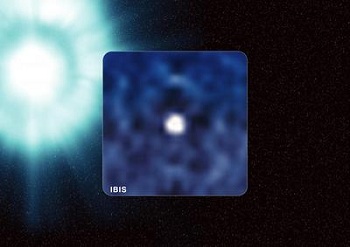
Indeed. Philippe Laurent is already talking about the significance of the result in helping us rule out some versions of string theory and some quantum loop gravity ideas. But many possibilities remain. The new findings that will come from further study will not displace earlier laws so much as extend them into new realms. In this sense past discoveries are rarely irrelevant, and it is a tribute to the coherency of physics that new perspectives so often incorporate earlier thinking. Thus Newton is not displaced by Einstein but becomes part of a more comprehensive synthesis.
Image: Integral’s IBIS instrument captured the gamma-ray burst (GRB) of 19 December 2004 that Philippe Laurent and colleagues have now analysed in detail. It was so bright that Integral could also measure its polarisation, allowing Laurent and colleagues to look for differences in the signal from different energies. The GRB shown here, on 25 November 2002, was the first captured using such a powerful gamma-ray camera as Integral’s. When they occur, GRBs shine as brightly as hundreds of galaxies each containing billions of stars. Credits: ESA/SPI Team/ECF.
Greene points out in The Hidden Reality that Isaac Newton himself never thought the laws he discovered were the only truths we would need. He saw a universe far richer than those his laws implied, and his statement on the fact is always worth quoting:
“I do not know what I may appear to the world, but to myself I seem to have only been a boy playing on the seashore, diverting myself in now and then finding a smoother pebble or prettier shell than ordinary, whilst the great ocean of truth lay before me all undiscovered.”
The impressive Integral results offer us data that may one day help in the unification of quantum theory and gravity. Thus the distant collapse of a massive star into a neutron star or a black hole during a supernova, the apparent cause of most GRBs, feeds new material to theoreticians and spurs the effort to probe even deeper. In the midst of this intellectual ferment, I strongly recommend Greene’s The Hidden Reality as a way to track recent cosmological thinking. I’ve spent weeks over this one, savoring the language, making abundant notes. Don’t miss it.
For more, see Laurent et al., “Constraints on Lorentz Invariance Violation using integral/IBIS observations of GRB041219A,” Physical Review D, Vol. 83, issue 12 (28 June, 2011). Abstract available.


